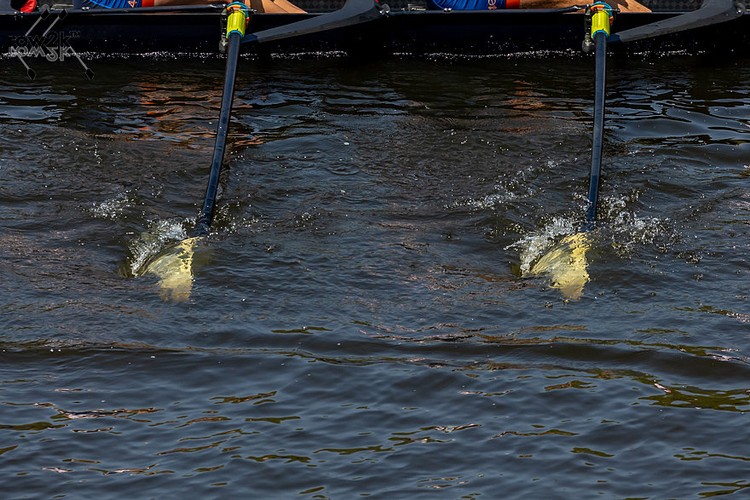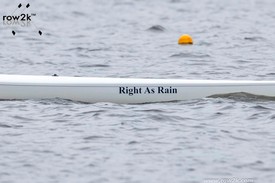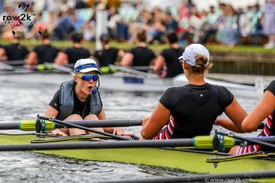
Did you know that:
- Only 80% of the drive length has more than half of the blade fully buried, thus is utilized to produce the blade's propulsive force.
- Peak force is achieved through an equal effort of the legs and upper body.
- The peak handle velocity is reached when the oar angle is near perpendicular to the boat.
These and other findings were revealed with further analysis of the averaged biomechanical curves obtained using the previously presented method, on over 50,000 data samples (RBN 2023/11).
The seat velocity was expressed as a percentage calculated from the peak handle velocity during the corresponding phase, not from its own peak. This approach allows for the comparison of handle and seat velocities and also facilitates the derivation of the rower’s upper body velocity (trunk+arms) as the difference between them.
At the catch (zero handle velocity), the force already reaches 13% of its maximal value due to overcoming oar inertia. Seat velocity reaches the 5% level (negative Catch Factor RBN 2015/09, 2022/08), and the blade is in its highest position.
At 10% of the drive length, the centre of the blade sinks below the water level, the force reaches 22%, and its curve bends upwards, while the rapid growth of handle velocity slows down at 44%, indicating the blade's "connection."
The seat velocity reaches its peak at 20% of the drive length, at slightly less than half of the maximum handle speed, while the upper body velocity is about three times slower and continues to grow. This point serves as a criterion for Rowing Style Factor as it usually corresponds with "the transition point" (RBN 2008/07, 2013/07). The handle force and velocity reach about 60% of their peak values, and the blade is fully submerged into the water at -3 degrees – a criterion for the Catch Slip.
The peak force is achieved at 40% of the drive length, when the handle speed is 83% of its maximum, the blade is at its deepest point, and seat and upper body velocities are nearly equal at 41% of peak handle speed.
The peak handle velocity coincides with 60% of the drive length – close to the perpendicular oar position relative to the boat. At this point, the force already drops down to 74%, the seat slows down, so 84% of the handle speed is contributed by the upper body.
At 90% of the drive length, the force drops down to zero and below, and the centre of the blade is slightly above the water level. The seat completely stops, so the whole handle velocity at 45% of its peak is contributed by the upper body
This study completes the development of reference curves for BioRow reports on biomechanical testing, which increases the quality of our data evaluation. Also, it could be useful for thoughtful and creative rowers and coaches: it is interesting to see how various variables interrelate during the drive phase and how different the recovery rhythm could be at low and high rates.
This is a short version of the BioRow Newsletter. Full text is available for BioRow members: https://biorow.com/membership/
If you enjoy and rely on row2k, we need your help to be able to keep doing all this. Though row2k sometimes looks like a big, outside-funded operation, it mainly runs on enthusiasm and grit. Help us keep it coming, thank you! Learn more.
Comments | Log in to comment |
There are no Comments yet
| |
- Bont Rowing
- Calm Waters Rowing
- Concept 2
- Craftsbury Sculling
- The Crew Classic
- CrewLAB
- Croker
- Dad Vail Regatta
- Durham Boat Co.
- Empacher
- Faster Masters
- Filippi
- Fluidesign
- h2row.net
- HUDSON
- myrow
- Nielsen-Kellerman
- Oak Ridge RA
- Peinert Boat Works
- Pocock Racing Shells
- Race1 USA
- Rockland Rowing Masters Regatta
- RowKraft
- Rubini Jewelers
- Vespoli USA
- WinTech Racing
- Bont Rowing
- Calm Waters Rowing
- Concept 2
- Craftsbury Sculling
- The Crew Classic
- CrewLAB
- Croker
- Dad Vail Regatta
- Durham Boat Co.
- Empacher
- Faster Masters
- Filippi
- Fluidesign
- h2row.net
- HUDSON
- myrow
- Nielsen-Kellerman
- Oak Ridge RA
- Peinert Boat Works
- Pocock Racing Shells
- Race1 USA
- Rockland Rowing Masters Regatta
- RowKraft
- Rubini Jewelers
- Vespoli USA
- WinTech Racing
















